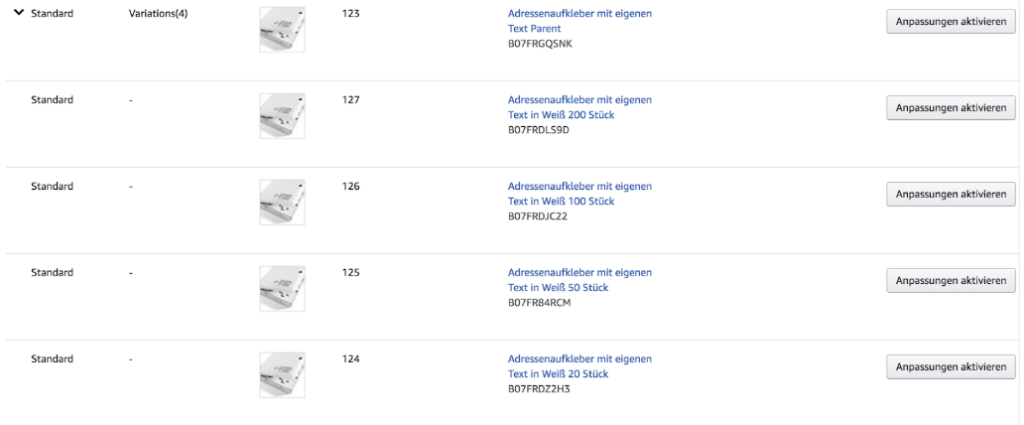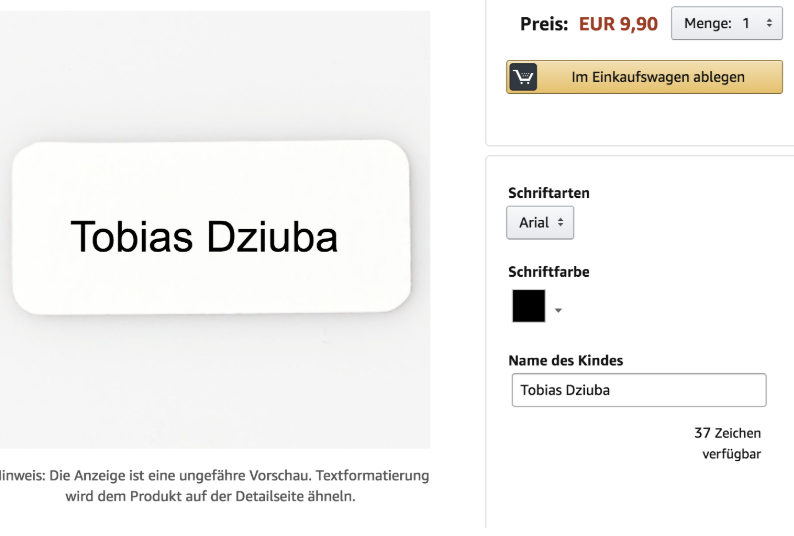Amazon is constantly working to further expand its marketplace in order to attract additional customers and retailers. In recent years, sales programs such as Amazon Launchpad, Amazon Handmade and Amazon Custom have been created. Through these sales programs, Amazon is now trying to gain untapped market shares in eCommerce. Amazon Launchpad, for example, is aimed at innovative start-ups that want to place their product on Amazon. By using the Amazon Launchpad programme, start-ups receive extended rights to personalize their product description. In addition, the products of participating startups are given a placement on the Launchpad page as well as the opportunity to use videos to present their products.
With Amazon Handmade, Amazon is pursuing the goal of offering handmade products, which are largely sold via platforms such as Etsy, on its own platform. Finally, there is the Amazon Custom programme, which now gives Amazon merchants the opportunity to personalize products directly on the Amazon platform. In this article, I will therefore discuss the use of Amazon Custom and how you, as a retailer/manufacturer of personalized products, can use the Amazon Custom function to sell your products.
What is Amazon Custom and what advantages does it offer?
With Amazon Custom you can products are offered on Amazonwhich are immediately adjusted or personalized on the product detail page. The personalization functions for the German marketplace are currently still somewhat limited, but it can be expected that the range of functions will be expanded in the future.
Before the launch of Amazon Custom, buyers of personalized products had to contact the retailer via the message form and submit their personalization requests. This ultimately led to many buyers being annoyed as the usability did not meet the eCommerce standards they were familiar with from conventional online stores. There was also resentment on the part of sellers, as the messages and personalization requests had to be processed "manually", which in turn resulted in lower performance in logistics. Now that Amazon Custom exists, every seller can offer their personalized products automatically. From my daily work, I know that the "Amazon Custom" function is not yet widespread, as most sellers are not yet familiar with this function.
The clear advantages of selling personalized products are the lower competitive pressure and the associated stable price level. In addition, many sellers of personalized products have not yet recognized the opportunities offered by Amazon Custom, meaning that sellers who react quickly can gain an edge over their competitors. Do you need support when selling on Amazon? Then we as Amazon Agency can certainly help.
Special features of Amazon Custom
Before you can start selling personalized products, you need to register with Amazon Custom. After Amazon has confirmed the request for Amazon Custom (usually within an hour), the first personalized products can be created. Please note that when selling personalized products, the "Add to cart" button is replaced by the "Customize now" button. Only after a customer has customized the respective product and confirmed the personalization can the desired product be placed in the shopping cart. As this intermediate step can lead to confusion for potential customers, it is advisable to use the first bullet point to display the personalization process.
How can I now offer personalized products on Amazon?
In the following, I will show you the personalization process step by step.
- Registration with Amazon Custom and confirmation from Amazon
- Creation and submission of the personalization mask
- Activation of the personalization mask
- Accept personalized orders

If Amazon has accepted the registration for Amazon Custom, you will see the sub-item "Personalized products" in the Seller Central menu. All products are listed here to activate the personalization function.

If we now click on "Activate customization", we can edit the personalization functions. In the first step, we need to upload an interface that will serve as a personalization template.

In the following example, I illustrate the personalization of name labels. Therefore, I have also uploaded the name label as an interface, which can be personalized by customers with the child's name and a predefined font and font color.
Finally, we select the type of personalization (text customization, image customization and options list) in the "Customization details" sub-item. In my example, this is a text customization, as the name labels are printed with the names of children.
![]()
In the next step, we define the customization details - such as pixel dimensions, character limit and print position of the text on the surface. As these details depend on the respective product, I cannot make any general statements here. 
The next step is to select the different fonts and font colors that can be used for personalization. Only four fonts are available by default (Verdana, Arial, Helvetica and Georgia) - however, additional fonts can be uploaded. It is important to note that the specified fonts cannot be applied automatically, but must first be activated. To do this, select the fonts that can be used and then click on "inactive".
Once we have defined the fonts, we only need to select the font colors. There are no Amazon specifications for the font colors.
The font colors offered can be defined by specifying the HTML color code and the name of the color.

In my example, I have now selected four font colors that customers can use when personalizing the name labels.
Now we just have to click on "Save and finish" before the personalization mask is finally released by an Amazon employee so that the products can be offered as personalized products. In my example, the personalization function looks like this:

Where can I find customers' order information for personalized products?
As usual, information on personalized orders can be found in Seller Central under Orders → Manage orders. Here you finally select the marked "personalized orders" and receive the required information on the personalization requests of the customers.
Conclusion: Amazon Custom - selling personalized products on Amazon:
With Amazon Custom, retailers of personalized products can add a personalization function to their products so that personalization requests no longer have to be dealt with via the message form or email correspondence. Ultimately, this benefits both customers and retailers. At present, the personalization function is not yet very advanced. We can therefore assume that corresponding functions will be integrated in the coming months and years so that products that can be fully personalized can also be offered and purchased on Amazon.

